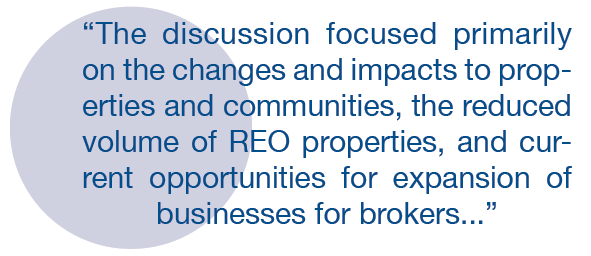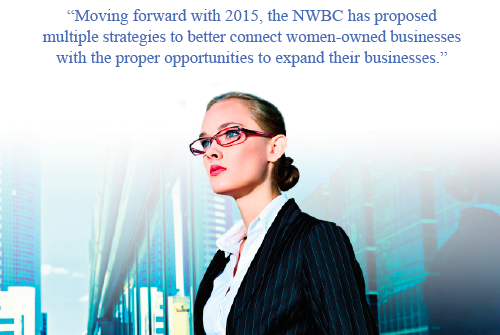
REOMAC’s 2015 Annual Education Summit & Expo in Dallas was a great success as the Association celebrated its 30th Anniversary with great style and substance. Attendees enjoyed exceptional Servicer Roundtables, Training Sessions, General Sessions, and Breakout Sessions—as well as two major social networking events, including the Annual REOMAC Foundation Charity Fundraiser.
One of the REOMAC panels was the GSE Update. Freddie Mac, Fannie Mae and GSEs continue to play a critical role in the mortgage default industry, related to vacant homes, foreclosure, and REO properties. The discussion included current initiatives for the broad default industry and what may be on the horizon. The moderator was Alfred Pollard, FHFA General Counsel. Panel participants included: Robert Klein, Community Blight Solutions/SecureView; Eric Will, Freddie Mac; Desirée Patno, NAWRB; and Rebecca Steele, Community Blight Solutions/SecureView.
 The discussion focused primarily on the changes and impacts to properties and communities, the reduced volume of REO properties, and current opportunities for expansion of businesses for brokers, especially for diverse and women-owned businesses. There were specific questions about how women entrepreneurs may register as Diverse Suppliers with the GSEs, and Desirée Patno clearly explained the requirements and the process to take advantage of Diverse Supplier registrations. Since the passage of Dodd-Frank Section 342, which established the Office of Minority and Women Inclusion (OMWI), there is an increased commitment to minority and women inclusion in the regulated entities and beyond. This was interesting to the group, as the volume of REOs has dramatically reduced in all markets across the United States.
The discussion focused primarily on the changes and impacts to properties and communities, the reduced volume of REO properties, and current opportunities for expansion of businesses for brokers, especially for diverse and women-owned businesses. There were specific questions about how women entrepreneurs may register as Diverse Suppliers with the GSEs, and Desirée Patno clearly explained the requirements and the process to take advantage of Diverse Supplier registrations. Since the passage of Dodd-Frank Section 342, which established the Office of Minority and Women Inclusion (OMWI), there is an increased commitment to minority and women inclusion in the regulated entities and beyond. This was interesting to the group, as the volume of REOs has dramatically reduced in all markets across the United States.
Another broad topic discussed was community blight impacts, and the focus on improving the maintenance of vacant properties. Panelists described the challenges as a result of the foreclosure crisis during the past eight years, and provided more solutions that improve and impact valuations, productive neighborhoods, and the housing economy. An update on significant issues and high-level discussions and strategies that are currently being discussed, tested, and deployed was also provided to attendees.
Vacant property preservation and securing properties continues to be a challenge for the GSEs and Servicers. Improvements in securing vacant properties include using Clear Boarding and replacing plywood in order to stabilize the neighborhoods and stabilize the values. It’s important to work with representatives such as local elected officials, land banks, FHFA, and banks/servicers to improve the collaboration with local governments to upgrade ways to handle vacant properties. This will improve protection for the neighborhoods.
These topics and impacts will continue to be important to both industry players and brokers, as the mortgage markets and delinquency continue to normalize. The ability to understand and embrace these market changes will be challenging, but will present new and different opportunities.
—

Rebecca Steele: Executive Vice President, Community Blight Solutions Inc; SecureView LLC

 Login
Login


















 It has long been said that imitation is the sincerest form of flattery. At City of Hope, researchers are implementing this concept of imitation—of making one thing similar to another—in a leading-edge approach to treating difficult cancers.
It has long been said that imitation is the sincerest form of flattery. At City of Hope, researchers are implementing this concept of imitation—of making one thing similar to another—in a leading-edge approach to treating difficult cancers.



 In 2015, we are committed to building on this important work and acting on the lessons learned with impactful
In 2015, we are committed to building on this important work and acting on the lessons learned with impactful
 The Council urged the implementation of an annual Survey of Business Owners and called on the Consumer Financial Protection Bureau to begin collection of data on demand for small business credit.
The Council urged the implementation of an annual Survey of Business Owners and called on the Consumer Financial Protection Bureau to begin collection of data on demand for small business credit. The data and methodology will be established in January 2015.
The data and methodology will be established in January 2015.


